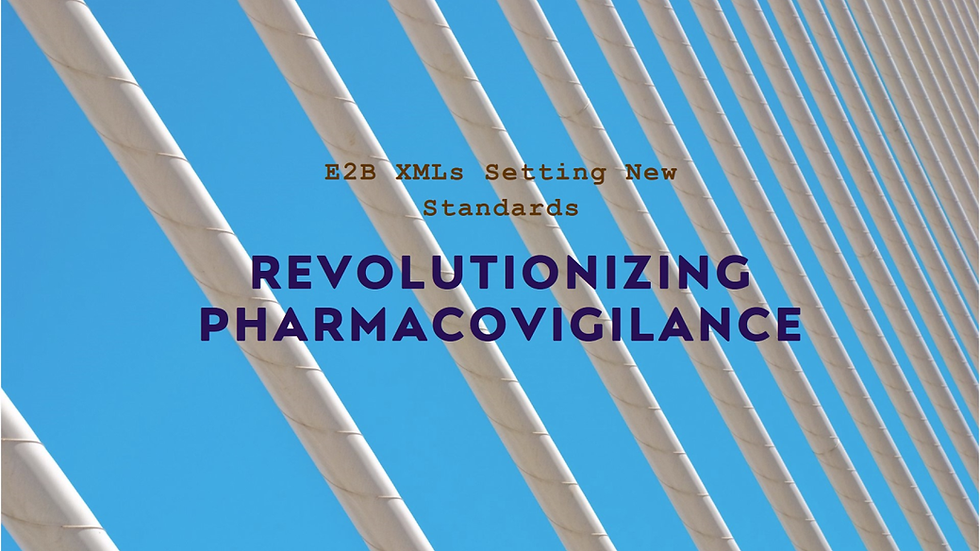
In the realm of pharmacovigilance, where patient safety is paramount, the way adverse event data is reported and managed plays a critical role. The adoption of E2B (R3) XML standards has ushered in a new era of reporting, offering enhanced efficiency, accuracy, and interoperability. In this blog post, we'll delve into how E2B XMLs are redefining pharmacovigilance reporting, setting new standards for the industry.
Understanding E2B XML:
E2B XML is a structured data format developed by the International Council for Harmonization of Technical Requirements for Pharmaceuticals for Human Use (ICH). It standardizes the electronic exchange of individual case safety reports (ICSRs) between regulatory authorities and pharmaceutical companies. Unlike its predecessors, E2B XML offers a more flexible and comprehensive approach to data exchange, enabling seamless integration with other systems and facilitating automation.
Enhanced Efficiency and Accuracy:
One of the primary benefits of E2B XML is its ability to streamline the reporting process, reducing manual errors and administrative burden. By standardizing data elements and encoding information in a machine-readable format, E2B XMLs minimize the risk of transcription errors and ensure consistency across reports. This not only saves time and resources but also improves the overall quality and reliability of pharmacovigilance data.
Interoperability and Integration:
E2B XMLs are designed to promote interoperability between different pharmacovigilance systems and stakeholders. The standardized format allows for seamless integration with electronic data capture (EDC) systems, safety databases, and regulatory authorities' systems. This interoperability facilitates the exchange of information in real-time, enabling faster decision-making and enhancing collaboration across the pharmacovigilance ecosystem.
Adaptability and Scalability:
Another key advantage of E2B XML is its adaptability and scalability to accommodate evolving regulatory requirements and technological advancements. The standard is designed to be flexible enough to support future enhancements and modifications, ensuring compatibility with emerging technologies and regulatory guidelines. This adaptability allows pharmaceutical companies to stay ahead of regulatory changes and maintain compliance without significant disruptions to their operations.
Improved Signal Detection and Risk Management:
The standardized format of E2B XMLs facilitates more robust signal detection and risk management processes. By capturing comprehensive and structured data, including patient demographics, medical history, and adverse event details, E2B XMLs enable sophisticated data analysis and trend identification. This enhances pharmacovigilance professionals' ability to detect potential safety signals early, assess risks more accurately, and take proactive measures to protect patient safety.
Regulatory Compliance and Global Harmonization:
E2B XMLs play a crucial role in ensuring regulatory compliance and promoting global harmonization in pharmacovigilance reporting. The standard is endorsed by regulatory authorities worldwide, including the U.S. Food and Drug Administration (FDA) and the European Medicines Agency (EMA), making it a universally accepted format for ICSR submissions. This harmonization simplifies the reporting process for pharmaceutical companies operating in multiple jurisdictions and promotes consistency in safety data exchange globally.
Challenges and Considerations:
While E2B XML offers numerous benefits, its implementation may pose challenges for some organizations. Technical expertise and resources are required to effectively integrate E2B XMLs into existing pharmacovigilance systems. Additionally, ensuring data quality and completeness remains crucial, as inaccuracies or omissions can impact signal detection and regulatory compliance. Pharmaceutical companies must invest in robust training and quality assurance processes to mitigate these challenges effectively.
Conclusion:
E2B XMLs represent a significant advancement in pharmacovigilance reporting, offering enhanced efficiency, accuracy, and interoperability. By standardizing data exchange and promoting global harmonization, E2B XMLs are setting new standards for the industry, driving improved patient safety and regulatory compliance. While challenges may arise during implementation, the benefits of adopting E2B XMLs far outweigh the costs, paving the way for a more streamlined and effective pharmacovigilance ecosystem.

Comments